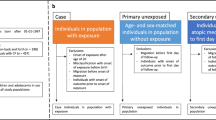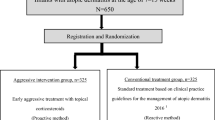Abstract
Background
Palivizumab is a humanized monoclonal antibody designed to provide passive immunity against respiratory syncytial virus. It is prescribed to children at high risk for severe infection with respiratory syncytial virus. However, little is known about the risk of the immune-mediated diseases atopic dermatitis, asthma, and allergic rhinoconjunctivitis after palivizumab exposure.
Aim
Our objective was to investigate whether exposure to palivizumab was associated with atopic dermatitis, asthma, or allergic rhinoconjunctivitis in childhood.
Methods
This was a cross-national population-based cohort study including data from 769,523 Danish children born 1 January 1999–31 December 2010 and 581,742 Swedish children born 1 July 2005–31 December 2010. Since palivizumab is only indicated for children at the highest risk, sub-cohorts of preterm children, children with bronchopulmonary dysplasia, and children with hemodynamic significant heart disease were defined.
Results
Of the 1,351,265 children included, 1192 (0.09%) were exposed to palivizumab. An increased risk of asthma after palivizumab exposure was observed in the total birth cohort (hazard ratio [HR] 1.49; 95% confidence interval [CI] 1.32–1.68) and in the sub-cohort of preterm children (HR 1.24; 95% CI 1.07–1.44). However, post hoc analyses using the propensity score to balance confounding factors found no increased risk of asthma in preterm children (HR 0.91; 95% CI 0.56–1.48). No increased risks of atopic dermatitis (HR 1.18; 95% CI 0.94–1.48) or allergic rhinoconjunctivitis (HR 1.14; 95% CI 0.92–1.42) were observed.
Conclusion
Exposure to palivizumab neither increased the risk of atopic disease nor protected against asthma.


Similar content being viewed by others
References
The IMpact-RSV Study Group. Palivizumab, a humanized respiratory syncytial virus monoclonal antibody, reduces hospitalization from respiratory syncytial virus infection in high-risk infants. Pediatrics. 1998;102(3 Pt 1):531–7.
Feltes TF, Sondheimer HM, Tulloh RM, Harris BS, Jensen KM, Losonsky GA, et al. A randomized controlled trial of motavizumab versus palivizumab for the prophylaxis of serious respiratory syncytial virus disease in children with hemodynamically significant congenital heart disease. Pediatr Res. 2011;70(2):186–91.
Melville JM, Moss TJ. The immune consequences of preterm birth. Front Neurosci. 2013;7:79.
Saez-Llorens X, Moreno MT, Ramilo O, Sanchez PJ, Top FH Jr, Connor EM. Safety and pharmacokinetics of palivizumab therapy in children hospitalized with respiratory syncytial virus infection. Pediatr Infect Dis J. 2004;23(8):707–12.
Grize L, Gassner M, Wuthrich B, Bringolf-Isler B, Takken-Sahli K, Sennhauser FH, et al. Trends in prevalence of asthma, allergic rhinitis and atopic dermatitis in 5–7-year old Swiss children from 1992 to 2001. Allergy. 2006;61(5):556–62.
Pedersen CB, Gotzsche H, Moller JO, Mortensen PB. The Danish Civil Registration System. A cohort of eight million persons. Dan Med Bull. 2006;53(4):441–9.
Ludvigsson JF, Otterblad-Olausson P, Pettersson BU, Ekbom A. The Swedish personal identity number: possibilities and pitfalls in healthcare and medical research. Eur J Epidemiol. 2009;24(11):659–67.
Knudsen LB, Olsen J. The Danish Medical Birth Registry. Dan Med Bull. 1998;45(3):320–3.
The swedish Patient Register. www.socialstyrelsen.se/register/halsodataregister/patientregistret. Accessed 12 Oct 2011.
Andersen TF, Madsen M, Jorgensen J, Mellemkjoer L, Olsen JH. The Danish National Hospital Register. A valuable source of data for modern health sciences. Dan Med Bull. 1999;46(3):263–8.
Gaist D, Sorensen HT, Hallas J. The Danish prescription registries. Dan Med Bull. 1997;44(4):445–8.
Wettermark B, Hammar N, Fored CM, Leimanis A, Otterblad OP, Bergman U, et al. The new Swedish Prescribed Drug Register—opportunities for pharmacoepidemiological research and experience from the first six months. Pharmacoepidemiol Drug Saf. 2007;16(7):726–35.
Bergman G, Haerskjold A, Stensballe LG, Kieler H, Linder M. Children with hemodynamically significant congenital heart disease can be identified through population-based registers. Clin Epidemiol. 2015;7:119–27.
Haerskjold A, Linder M, Henriksen L, Thomsen SF, Kieler H, Ravn H, Stensballe LG. Palivizumab exposure in early childhood and the risk of autoimmune disease: a cross-national cohort study. Paediatr Drugs. 2016;18(6):435–41.
Henriksen L, Simonsen J, Haerskjold A, Linder M, Kieler H, Thomsen SF, et al. Incidence rates of atopic dermatitis, asthma, and allergic rhinoconjunctivitis in Danish and Swedish children. J Allergy Clin Immunol. 2015;136(2):360–6.
Haerskjold A, Henriksen L, Way S, Malham M, Hallas J, Pedersen L, et al. The Danish National Prescription Registry in studies of a biological pharmaceutical: palivizumab–validation against two external data sources. Clin Epidemiol. 2015;7:305–12.
Linder M, Bystrom C, Kieler H, Bergman G, Haerskjold A. Use of palivizumab is underestimated in the Swedish Prescribed Drug Register—implications for register-based drug studies. Clin Epidemiol. 2015;7:45–51.
Henderson J, Hilliard TN, Sherriff A, Stalker D, Al SN, Thomas HM. Hospitalization for RSV bronchiolitis before 12 months of age and subsequent asthma, atopy and wheeze: a longitudinal birth cohort study. Pediatr Allergy Immunol. 2005;16(5):386–92.
Lemanske RF Jr. Early-life wheezing and respiratory syncytial virus prevention. N Engl J Med. 2013;368(19):1839–41.
Szabo SM, Levy AR, Gooch KL, Bradt P, Wijaya H, Mitchell I. Elevated risk of asthma after hospitalization for respiratory syncytial virus infection in infancy. Paediatr Respir Rev. 2013;13(Suppl 2):S9–15.
Yoshihara S, Kusuda S, Mochizuki H, Okada K, Nishima S, Simoes EA. Effect of palivizumab prophylaxis on subsequent recurrent wheezing in preterm infants. Pediatrics. 2013;132(5):811–8.
Simoes EA, Groothuis JR, Carbonell-Estrany X, Rieger CH, Mitchell I, Fredrick LM, et al. Palivizumab prophylaxis, respiratory syncytial virus, and subsequent recurrent wheezing. J Pediatr. 2007;151(1):34–42.
Simoes EA, Carbonell-Estrany X, Rieger CH, Mitchell I, Fredrick L, Groothuis JR. The effect of respiratory syncytial virus on subsequent recurrent wheezing in atopic and nonatopic children. J Allergy Clin Immunol. 2010;126(2):256–62.
Blanken MO, Rovers MM, Molenaar JM, Winkler-Seinstra PL, Meijer A, Kimpen JL, et al. Respiratory syncytial virus and recurrent wheeze in healthy preterm infants. N Engl J Med. 2013;368(19):1791–9.
Porterfield JS. Antibody-dependent enhancement of viral infectivity. J Adv Virus Res. 1986;31:335–55.
Turti TV, Baibarina EN, Degtiareva EA, et al. A prospective, open-label, non-comparative study of palivizumab prophylaxis in children at high risk of serious respiratory syncytial virus disease in the Russian Federation. BMC Res Notes. 2012;5:484.
Synagis (palivizumab). London: European Medicines Agency. www.ema.europa.eu/ema/index.jsp?curl=pages/medicines/human/medicines/000257/human_med_001070.jsp&mid=WC0b01ac058001d124. Accessed 2 Dec 2014.
Recommendations for prescription of Synagis to preterm infants. Danish Society of Pediatrics, Committee of Neonatology and Infectious diseases. 2002 [in Danish]. http://www.paediatri.dk/images/pdf_filer/dps_vejl/neo/013neo.pdf. Accessed 10 June 2014.
Recommendation for palivizumab [in Swedish]. www.lakemedelsverket.se/malgrupp/Halsosjukvard/Behandlings–rekommendationer/Behandlingsrekommendation—listan/RSV-infektioner. Accessed 10 June 2014.
Prevention of RSV infections in children with congenital heart disease. Palivizumab [in Danish]. 2004. http://www.paediatri.dk/images/pdf_filer/dps_vejl/001kar.pdf. Accessed 10 June 2014.
Author information
Authors and Affiliations
Corresponding author
Ethics declarations
Funding
The study was an investigator-driven study funded by AbbVie. AbbVie provided a scientific review, but all decisions regarding the study design, the statistical analyses, and the manuscript were made by the authors.
Conflicts of interest
Abbvie provided a research grant to Karolinska Institute in Sweden and Rigshospitalet in Denmark. The wages of Ann Haerskjold, Lonny Stokholm, and Henrik Ravn were covered by a grant from Abbvie. Marie Linder, Simon Thomsen, Gunnar Bergmann, Ingegärd Berglind, Helle Kieler and Lone Stensballe have no financial relationships relevant to this article.
Electronic supplementary material
Below is the link to the electronic supplementary material.
Rights and permissions
About this article
Cite this article
Haerskjold, A., Stokholm, L., Linder, M. et al. Palivizumab Exposure and the Risk of Atopic Dermatitis, Asthma and Allergic Rhinoconjunctivitis: A Cross-National, Population-Based Cohort Study. Pediatr Drugs 19, 155–164 (2017). https://doi.org/10.1007/s40272-017-0215-7
Published:
Issue Date:
DOI: https://doi.org/10.1007/s40272-017-0215-7




